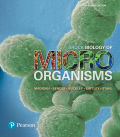
EBK BROCK BIOLOGY OF MICROORGANISMS
15th Edition
ISBN: 8220103633352
Author: Stahl
Publisher: PEARSON
expand_more
expand_more
format_list_bulleted
Question
Chapter 28.1, Problem 1CR
Summary Introduction
Laboratory-associated infections (LAIs) are also known as laboratory-acquired infections or occupational illness. LAIs may arise in clinical laboratories, animal facilities, and also in production installations. LAIs are of community health concern, as an infected worker may transmit the infection to his relatives, colleagues, and family members. In the United States (U.S) about 500,000 laboratory workers are at risk of exposure to contagious agents, which may cause diseases that vary from mild to life-threatening infections.
Expert Solution & Answer
Want to see the full answer?
Check out a sample textbook solution
Students have asked these similar questions
What are “healthcare-associated infections” (HAI)and how are they acquired? What problems can theycause?
Discuss both persistent and transforming infections.
Q. Because you love to work with children, you accept a job offer at a local pediatric clinic. A concerned mother brings herdaughter who had eye infection (pink eye, caused by gram-negative bacteria). The doctor prescribes her Cephalosporinantimicrobial drug. After a few days, the mother returned to the clinic and complained that the medicine did not help herdaughter. This time, the physician prescribes Penicillin antimicrobial drugs. However, based on your knowledge inmicrobiology class answer:1) why Cephalosporins does not eliminate the bacteria? 2) why do you think the Penicillin antimicrobial drugs will not help the little girl, and the physician should prescribe aStreptomycin antimicrobial drug as eye drops? 3) If the same bacteria develop resistance to Streptomycin, describe the bacteria's possible resistance method against thisantimicrobial drug?
Chapter 28 Solutions
EBK BROCK BIOLOGY OF MICROORGANISMS
Ch. 28.1 - The use of personal protective equipment (PPE) is...Ch. 28.1 - Identify and discuss the standard safety...Ch. 28.1 - Prob. 1CRCh. 28.2 - Prob. 1MQCh. 28.2 - How can the spread of HAIs be controlled?Ch. 28.2 - Prob. 1CRCh. 28.3 - What are the key points necessary for proper...Ch. 28.3 - Identify culture methods and conditions used for...Ch. 28.3 - QWhy is it important to process clinical specimens...Ch. 28.4 - Describe the disc diffusion test and the Etest for...
Ch. 28.4 - What is the value of antimicrobial drug...Ch. 28.4 - QDescribe the disc diffusion test for antibiotic...Ch. 28.5 - Explain the reasons for changes in antibody titer...Ch. 28.5 - Describe the method, time frame, and rationale for...Ch. 28.5 - What advantages do monoclonal antibodies have...Ch. 28.5 - QWhy does antibody titer rise after infection? Is...Ch. 28.6 - How is the bivalence of antibodies significant for...Ch. 28.6 - What are the advantages and disadvantages of...Ch. 28.6 - Why are agglutination tests so widely used in...Ch. 28.7 - Prob. 1MQCh. 28.7 - Compare the advantages and disadvantages of EIA,...Ch. 28.7 - Prob. 1CRCh. 28.8 - What advantage(s) does nucleic acid amplification...Ch. 28.8 - How do quantitative PCR (qPCR) and qualitative PCR...Ch. 28.8 - Distinguish between quantitative and qualitative...Ch. 28.9 - Compare and contrast live attenuated vaccines,...Ch. 28.9 - Identify the advantages of alternative...Ch. 28.9 - QList the immunizations recommended for children...Ch. 28.10 - Prob. 1MQCh. 28.10 - How does the activity of each antibiotic class...Ch. 28.10 - What are the sources of aminoglycosides,...Ch. 28.10 - Antibiotics are chemically diverse antimicrobial...Ch. 28.11 - What steps in the viral maturation process are...Ch. 28.11 - Why are there fewer clinically effective...Ch. 28.11 - Why is host toxicity a common problem with...Ch. 28.12 - Identify the basic mechanisms of antibiotic...Ch. 28.12 - What does vancomycin have in common with...Ch. 28.12 - Prob. 3MQCh. 28.12 - What practices contribute to the spread of...Ch. 28 - Define the procedures you would use to isolate and...Ch. 28 - Prob. 2AQCh. 28 - Describe three important reasons why semisynthetic...Ch. 28 - Imagine yourself as a clinical microbiologist with...
Knowledge Booster
Learn more about
Need a deep-dive on the concept behind this application? Look no further. Learn more about this topic, biology and related others by exploring similar questions and additional content below.Similar questions
- Explain the Development of Aseptic Techniques introduced by Joseph Lister.arrow_forwardQ#1: Describe morphology, vectors and pathogenesis of Wuchereria bancrofti?arrow_forwardDiscuss important aspects of health-care-associated infections andtheir impact on patients in clinical settings.arrow_forward
- Q How is Neisseria meningitides typically transmittedand what are the symptoms of full-blown meningitiscaused by this bacterium?arrow_forwardWhat is epidemiology? there are several ways pathogens can be transmitted including direct contact, indirect contact, via respiratory droplets, vehicle, and through a vector. Describe each mode IN DETAIL and give an example of a pathogen that can be transmitted each way.arrow_forwardThe purpose of an analytical study is toa) identify the person, place, and time of an outbreak.b) identify risk factors that result in high frequencies of disease.c) assess the effectiveness of preventive measures.d) determine the effectiveness of a placebo.e) None of the abovearrow_forward
- Discuss an Infection? Give examplesarrow_forwardDescribe the mechanism of action of tetracycline antibiotics and describe their importance for clinical infections.arrow_forwardQ#3: Describe the global epidemiology of Trypanosoma brucei. What are the various methods for the detection of T. brucei?arrow_forward
arrow_back_ios
SEE MORE QUESTIONS
arrow_forward_ios
Recommended textbooks for you


Infectious Diseases - How do we control them?; Author: Let's Learn Public Health;https://www.youtube.com/watch?v=2JWku3Kjpq0;License: Standard Youtube License